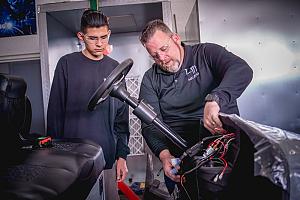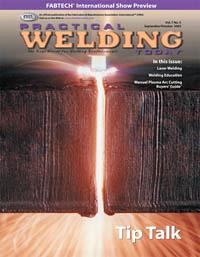Contributing Writer
- FMA
- The Fabricator
- FABTECH
- Canadian Metalworking
Categories
- Additive Manufacturing
- Aluminum Welding
- Arc Welding
- Assembly and Joining
- Automation and Robotics
- Bending and Forming
- Consumables
- Cutting and Weld Prep
- Electric Vehicles
- En Español
- Finishing
- Hydroforming
- Laser Cutting
- Laser Welding
- Machining
- Manufacturing Software
- Materials Handling
- Metals/Materials
- Oxyfuel Cutting
- Plasma Cutting
- Power Tools
- Punching and Other Holemaking
- Roll Forming
- Safety
- Sawing
- Shearing
- Shop Management
- Testing and Measuring
- Tube and Pipe Fabrication
- Tube and Pipe Production
- Waterjet Cutting
Industry Directory
Webcasts
Podcasts
FAB 40
Advertise
Subscribe
Account Login
Search
Budget cuts hit welding hard
Extraordinary effort is critical to welding programs survival
- By Stephanie Vaughan
- September 25, 2003
- Article
- Shop Management
 |
Bill Garner is outraged when he hears that Connecticut, where he teaches welding, would rather import welders than keep adult vocational education programs that train the state's own residents.
"I don't think that the people making this decision understand that welding is used in business today," said Garner, a welding instructor at the Howell Cheney Regional Vocational High School in Manchester, Conn.
Many others in the welding industry feel the same way, and that is leading instructors and welding companies to consider a more proactive approach to protecting welding programs and attracting more people into the industry.
An Education System in Crisis
Bob Hollingsworth is no stranger to cutbacks in welding programs. As adjunct instructor of manufacturing engineering technology at Western Washington University in Bellingham, Wash., he has witnessed firsthand the decrease in the prominence of welding in the school's program.
 |
"They cut the welding facility down and pumped up the foundry into the curriculum," Hollingsworth said. "I'm seeing a lot of that going on."
Biazzio Giordano echoed Hollingsworth's concerns from the other side of the nation.
"It seems like the programs are dying all around us on the East Coast," said Giordano, a welding teacher in the Career Technology Education Department of Parkside High School in Salisbury, Md.
Welding programs aren't just being cut, though; many have been absorbed into other courses, which dilutes the welding education some schools offer.
"I see secondary welding programs being looked at and administrators looking at ways to combine them with other programs," said Dennis Klingman, chairman of the American Welding Society (AWS) Education Committee and manager of technical training at The Lincoln Electric Co., Cleveland. "Schools are looking at welding programs as expensive."
 |
While Marty Rice hasn't personally experienced the cuts that many other welding instructors have faced, he knows how difficult it is to get the financial backing he needs to run good-quality classes for his students.
"This is the spookiest time in welding education I've ever seen," said Rice, an instructor at the Dale Jackson Career Center in Lewisville, Texas, and member of Iron Workers Local 263. "These cuts are very demoralizing.
"We have to fight for dollars as it is, so if government funding is cut, it's a noose around our neck," Rice said. "I get a general budget and an activities fund. The general budget is for the teaching materials, and the activities fund is for a project the students want to make. We sell those projects and put the money back into the activities fund—but the activities fund isn't enough to support your programs."
Image Is Everything
Welding courses are in trouble for several reasons.
"Changes have been made in the increasing number of high-tech areas, while the number of welding programs has diminished," said Robert Martin, education consultant for the Connecticut Vocational-Technical School System. He's been with the department for more than 12 years.
"Part of this is because high schools tell their students that they need a college degree to do anything, which is not true," Martin said. "Another part of this is that welding is not a glamorous trade that attracts young people to it. It's more of an adult trade in that adults get into welding because welders are always working."
 |
One of the first issues those in welding say they have to contend with is the image of the industry and of manufacturing in general.
"Image is a huge issue," Klingman said. "Welding shops [in the schools] didn't look as good as other shops because they needed ventilation and to keep the machines clean. Sometimes they looked like a steel warehouse because they accepted so many donations from manufacturing companies. They didn't look as good as other shops because they didn't look as modern as the rest of the school, and the school pays attention to the image it's presenting to parents and students. For a lot of schools, it boiled down to that the welding shop didn't look like other shops. They were either going to have to change or not be there.
"But visual image is just one part of it," Klingman said. "The second part of image is that people think you're going to be a welder in a shop for the rest of your life, but that's not the norm. Being a welder is an entry-level position. Many move on to be foremen, supervisors, and business owners."
Klingman said a lot of schools have worked through these issues successfully, while other schools are still dealing with the threat or reality of cuts in their welding departments.
A Proactive Approach
Welding professionals interviewed for this article agree that it takes extra effort to reach out to and attract more people into the welding industry.
Part of that rests on the instructors teaching welding at any level, according to Rice.
"As an instructor, you have to promote your program. You have to get some energy into your program," he said. "I stress artwork and sculpture to my students. I tell them they can make anything as long as it's not illegal or obscene. This gets their interest because art's big right now. And you can tie it all in with research, planning, supervising, robotics—it's a stepping stone once they get that practical experience and the feel of welding."
Giordano agreed.
"The hard trades are not glamorous, and people are not attracted to them," he said. "We have to show them that it's not all dirt and grime, that it's a lot more computerized, like in the aerospace industry."
Giordano also thinks it's important to have people heading welding programs who have faith and believe in putting money into the programs. Parkside High School, for instance, started an exploratory program to get 10th-graders in to see what welding is all about.
 |
"You have to show them that there's a future out there for good-paying jobs; that you don't have to be a Joe's Welding Shop if you don't want to; that you can work in shipbuilding and aerospace," he said.
Hollingsworth said he thinks a formal emphasis needs to be placed on the image of welding, one that includes facts, audiovisual presentations, and a resource for questions, all of which target school boards and administrators.
"We have to enhance our visibility. We need a SWAT team for welding," he said. "Welding courses are being cut, but people are calling me, looking for qualified welders."
Klingman said that instructors who need help with sustaining their welding programs can call the AWS Department of Education, which has information on the importance of welding that they can send out.
Currently, he said, AWS is developing a database of secondary and postsecondary welding programs, their instructors, and school administrators to identify schools in need of assistance and provide them with useful information to help their programs thrive. This information includes government issues that affect them directly, advice on helping them sustain and start new programs, and reviews of rewrites of programs to make sure that they're including the curriculum they should. The AWS also has produced two commercials that highlight the importance of welding and are designed to recruit more people into the trade.
AWS and other organizations, such as the Precision Metalforming Association (PMA), Independence, Ohio, are focusing on working with the government in decision-making for welding and manufacturing programs. The military and apprenticeship institutions also are getting increasingly involved in manufacturing on a more proactive basis because of their need for skilled labor, Klingman said.
For example, some apprenticeship programs incorporate associate degrees to attract more people into apprenticeships so they can earn money, practical experience, and a degree all at the same time.
"They're [apprenticeship program coordinators] saying, 'We have too few students coming out of the state programs that are being shut down,' so they're offering a combined effort," Klingman said. "They know they want to find young, high-quality people to be part of their programs."
The Future of Welding Education
As more and more people understand the role that manufacturing plays in our lives every day, many welding professionals hope that the trend of eliminating welding courses will come to an end.
This is especially important to adult vocational education courses that are being cut, according to Klingman.
"Adult education is more important than ever, because adults need to find skill sets that can provide them with a continuous income," he said. "Look at the huge numbers of companies that are laying off people in industry. Sometimes adults need to follow a different career path, and welding provides a broad skill set that can help them gain continuous employment."
Even more important, though, is that administrators and government officials who decide which programs remain in the nation's vocational-technical school systems understand the value of manufacturing and the efforts that many are making to preserve the training necessary to produce skilled workers, Klingman said.
"To be the world leader in industry, we cannot export out skill sets with good pay and excellent careers," Klingman said. "We have those opportunities here, and we don't want to give them away."
"I think that we—meaning administrators, the public, and the government—are going to learn more about what part welding plays in our lives than ever before. We're going to have to deliver a lot more information in the next 24 months than we ever have before about the importance of welding to our living standards, our freedom, and the future of industrial America."
About the Author

About the Publication
subscribe now

The Welder, formerly known as Practical Welding Today, is a showcase of the real people who make the products we use and work with every day. This magazine has served the welding community in North America well for more than 20 years.
start your free subscription- Stay connected from anywhere

Easily access valuable industry resources now with full access to the digital edition of The Fabricator.

Easily access valuable industry resources now with full access to the digital edition of The Welder.

Easily access valuable industry resources now with full access to the digital edition of The Tube and Pipe Journal.
- Podcasting
- Podcast:
- The Fabricator Podcast
- Published:
- 05/14/2024
- Running Time:
- 62:12
Cameron Adams of Laser Precision, a contract metal fabricator in the Chicago area, joins the podcast to talk...
- Trending Articles
Connecticut students compete in Maritime Welding Competition

Welding power source’s modes designed to help optimize performance

Building a successful welding program from the ground up

Torch made for welding thin, conductive sheet metal

Welding jacket designed for protection, comfort

- Industry Events
Laser Welding Certificate Course
- May 7 - August 6, 2024
- Farmington Hills, IL
World-Class Roll Forming Workshop
- June 5 - 6, 2024
- Louisville, KY
Advanced Laser Application Workshop
- June 25 - 27, 2024
- Novi, MI
Precision Press Brake Certificate Course
- July 31 - August 1, 2024
- Elgin,


























